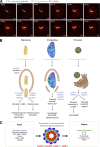Interferon-induced guanylate-binding proteins: Guardians of host defense in health and disease
- PMID: 30755454
- PMCID: PMC6400534
- DOI: 10.1084/jem.20182031
Interferon-induced guanylate-binding proteins: Guardians of host defense in health and disease
Abstract
Guanylate-binding proteins (GBPs) have recently emerged as central orchestrators of immunity to infection, inflammation, and neoplastic diseases. Within numerous host cell types, these IFN-induced GTPases assemble into large nanomachines that execute distinct host defense activities against a wide variety of microbial pathogens. In addition, GBPs customize inflammasome responses to bacterial infection and sepsis, where they act as critical rheostats to amplify innate immunity and regulate tissue damage. Similar functions are becoming evident for metabolic inflammatory syndromes and cancer, further underscoring the importance of GBPs within infectious as well as altered homeostatic settings. A better understanding of the basic biology of these IFN-induced GTPases could thus benefit clinical approaches to a wide spectrum of important human diseases.
© 2019 Tretina et al.
Figures





Similar articles
-
Interferon-induced guanylate-binding proteins in inflammasome activation and host defense.Nat Immunol. 2016 May;17(5):481-9. doi: 10.1038/ni.3440. Nat Immunol. 2016. PMID: 27092805 Free PMC article.
-
Cell-autonomous immunity by IFN-induced GBPs in animals and plants.Curr Opin Immunol. 2019 Oct;60:71-80. doi: 10.1016/j.coi.2019.04.017. Epub 2019 Jun 6. Curr Opin Immunol. 2019. PMID: 31176142 Free PMC article. Review.
-
Regulation of innate immune functions by guanylate-binding proteins.Int J Med Microbiol. 2018 Jan;308(1):237-245. doi: 10.1016/j.ijmm.2017.10.013. Epub 2017 Nov 2. Int J Med Microbiol. 2018. PMID: 29174633 Review.
-
Guanylate Binding Proteins Restrict Leishmania donovani Growth in Nonphagocytic Cells Independent of Parasitophorous Vacuolar Targeting.mBio. 2020 Jul 28;11(4):e01464-20. doi: 10.1128/mBio.01464-20. mBio. 2020. PMID: 32723921 Free PMC article.
-
Human guanylate binding proteins: nanomachines orchestrating host defense.FEBS J. 2021 Oct;288(20):5826-5849. doi: 10.1111/febs.15662. Epub 2021 Jan 12. FEBS J. 2021. PMID: 33314740 Free PMC article. Review.
Cited by
-
Analysis of gene expression profile of peripheral blood in alveolar and cystic echinococcosis.Front Cell Infect Microbiol. 2022 Aug 11;12:913393. doi: 10.3389/fcimb.2022.913393. eCollection 2022. Front Cell Infect Microbiol. 2022. PMID: 36034715 Free PMC article.
-
Candidate genes and sequence variants for susceptibility to mycobacterial infection identified by whole-exome sequencing.Front Genet. 2022 Oct 20;13:969895. doi: 10.3389/fgene.2022.969895. eCollection 2022. Front Genet. 2022. PMID: 36338958 Free PMC article.
-
Multiplexed Spatial Profiling of Hodgkin Reed-Sternberg Cell Neighborhoods in Classic Hodgkin Lymphoma.Clin Cancer Res. 2024 Sep 3;30(17):3881-3893. doi: 10.1158/1078-0432.CCR-24-0942. Clin Cancer Res. 2024. PMID: 38949890 Free PMC article.
-
Quantitative proteomics reveals differential extracellular vesicle cargo from M1 and M2 monocyte-derived human macrophages.bioRxiv [Preprint]. 2024 Sep 21:2024.09.17.613483. doi: 10.1101/2024.09.17.613483. bioRxiv. 2024. PMID: 39345606 Free PMC article. Preprint.
-
Diversity of satellite glia in sympathetic and sensory ganglia.Cell Rep. 2022 Feb 1;38(5):110328. doi: 10.1016/j.celrep.2022.110328. Cell Rep. 2022. PMID: 35108545 Free PMC article.
References
Publication types
MeSH terms
Substances
Associated data
- Actions

